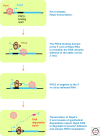The X as model for RNA's niche in epigenomic regulation
- PMID: 20739414
- PMCID: PMC2926758
- DOI: 10.1101/cshperspect.a003749
The X as model for RNA's niche in epigenomic regulation
Abstract
The X-linked region now known as the "X-inactivation center" (Xic) was once dominated by protein-coding genes but, with the rise of Eutherian mammals some 150-200 million years ago, became infiltrated by genes that produce long noncoding RNA (ncRNA). Some of the noncoding genes have been shown to play crucial roles during X-chromosome inactivation (XCI), including the targeting of chromatin modifiers to the X. The rapid establishment of ncRNA hints at a possible preference for long transcripts in some aspects of epigenetic regulation. This article discusses the role of RNA in XCI and considers the advantages RNA offers in delivering allelic, cis-limited, and locus-specific control. Unlike proteins and small RNAs, long ncRNAs are tethered to the site of transcription and effectively tag the allele of origin. Furthermore, long ncRNAs are drawn from larger sequence space than proteins and can mark a unique region in a complex genome. Thus, like their small RNA cousins, long ncRNAs may emerge as versatile and powerful regulators of the epigenome.
Figures




Similar articles
-
Lessons from X-chromosome inactivation: long ncRNA as guides and tethers to the epigenome.Genes Dev. 2009 Aug 15;23(16):1831-42. doi: 10.1101/gad.1811209. Genes Dev. 2009. PMID: 19684108 Free PMC article.
-
The long noncoding RNA, Jpx, is a molecular switch for X chromosome inactivation.Cell. 2010 Oct 29;143(3):390-403. doi: 10.1016/j.cell.2010.09.049. Cell. 2010. PMID: 21029862 Free PMC article.
-
Long Noncoding RNAs and X Chromosome Inactivation.Prog Mol Subcell Biol. 2011;51:43-64. doi: 10.1007/978-3-642-16502-3_3. Prog Mol Subcell Biol. 2011. PMID: 21287133
-
Origin and evolution of the long non-coding genes in the X-inactivation center.Biochimie. 2011 Nov;93(11):1935-42. doi: 10.1016/j.biochi.2011.07.009. Epub 2011 Jul 27. Biochimie. 2011. PMID: 21820484 Review.
-
The role of noncoding RNAs in chromatin regulation during differentiation.Wiley Interdiscip Rev Dev Biol. 2012 Sep-Oct;1(5):743-52. doi: 10.1002/wdev.41. Epub 2012 Feb 22. Wiley Interdiscip Rev Dev Biol. 2012. PMID: 23799570 Review.
Cited by
-
The RNA worlds in context.Cold Spring Harb Perspect Biol. 2012 Jul 1;4(7):a006742. doi: 10.1101/cshperspect.a006742. Cold Spring Harb Perspect Biol. 2012. PMID: 21441585 Free PMC article.
-
Uncoupling transcription from covalent histone modification.PLoS Genet. 2014 Apr 10;10(4):e1004202. doi: 10.1371/journal.pgen.1004202. eCollection 2014 Apr. PLoS Genet. 2014. PMID: 24722509 Free PMC article.
-
Overexpression of long noncoding RNA PCAT-1 is a novel biomarker of poor prognosis in patients with colorectal cancer.Med Oncol. 2013;30(2):588. doi: 10.1007/s12032-013-0588-6. Epub 2013 May 3. Med Oncol. 2013. PMID: 23640607
-
Non-coding telomeric and subtelomeric transcripts are differentially regulated by telomeric and heterochromatin assembly factors in fission yeast.Nucleic Acids Res. 2012 Apr;40(7):2956-63. doi: 10.1093/nar/gkr1155. Epub 2011 Dec 1. Nucleic Acids Res. 2012. PMID: 22139922 Free PMC article.
-
Biological implications and regulatory mechanisms of long-range chromosomal interactions.J Biol Chem. 2013 Aug 2;288(31):22369-77. doi: 10.1074/jbc.R113.485292. Epub 2013 Jun 18. J Biol Chem. 2013. PMID: 23779110 Free PMC article. Review.
References
-
- Anguera MC, Sun BK, Xu N, Lee JT 2006. X-chromosome kiss and tell: How the Xs go their separate ways. Cold Spring Harb Symp Quant Biol 71: 429–437 - PubMed
-
- Avner P, Heard E 2001. X-chromosome inactivation: Counting, choice and initiation. Nat Rev Genet 2: 59–67 - PubMed
-
- Bacher CP, Guggiari M, Brors B, Augui S, Clerc P, Avner P, Eils R, Heard E 2006. Transient colocalization of X-inactivation centres accompanies the initiation of X inactivation. Nat Cell Biol 8: 293–299 - PubMed
-
- Bartolomei MS, Zemel S, Tilghman SM 1991. Parental imprinting of the mouse H19 gene. Nature 351: 153–155 - PubMed
-
- Bell AC, West AG, Felsenfeld G 1999. The protein CTCF is required for the enhancer blocking activity of vertebrate insulators. Cell 98: 387–396 - PubMed
Publication types
MeSH terms
Substances
Grants and funding
LinkOut - more resources
Full Text Sources
Other Literature Sources
